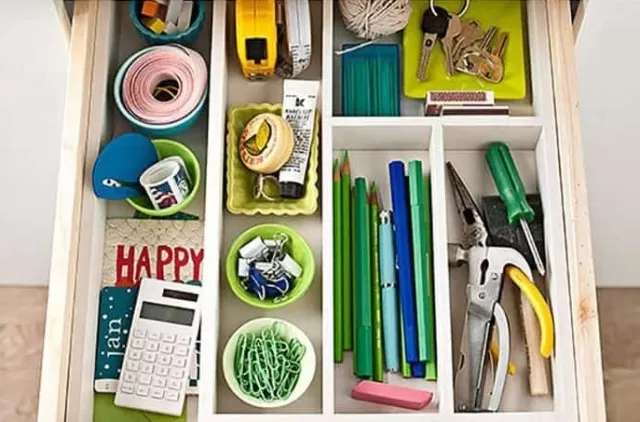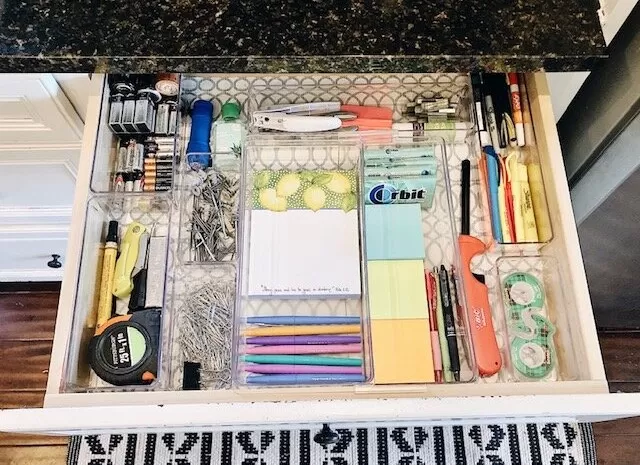Even individuals who excel at the organization of a Junk Drawer often have a designated spot where miscellaneous items are.
Why do we have to Organize a Junk Drawer

Reasons to Organize a Junk Drawer.
Even individuals who excel at organization often have a designated spot where miscellaneous items are temporarily placed for later attention.
This spot is commonly known as the junk drawer, where keys, pens, takeout menus, and various other odds and ends find their way either because they require frequent access or simply lack a designated place.
If you struggle with managing a junk drawer, there’s no need to worry.
Bringing order to a cluttered drawer is simpler than you might imagine. By following our straightforward step-by-step process, you can transform a chaotic drawer into an organized storage space that serves your family’s needs.
The task of organizing your junk drawer demands minimal time and Resources but can yield significant benefits.
Organizations Tips for a Junk Drawer

Best Organizations Tips for a Junk Drawer.
1. Take Measurements
To use organizers in your drawer, you’ll need to measure both the drawer and the organizers.
Carefully record the width, depth, and height of the drawer. If the junk drawer is excessively filled, you may need to relocate items or empty the drawer to obtain accurate measurements.
Once you have the measurements, it’s time to find suitable organizers.
You can either repurpose existing items or purchase new ones.
Here are a few popular options for organizing a junk drawer:
- Individual inserts: These are versatile as they come in various sizes and can be rearranged as needed. They usually consist of several small containers that can be configured to fit your requirements.
- Organizer tray: Typically expandable, an organizer tray contains compartments of different sizes but cannot be reconfigured like inserts.
- Drawer dividers: While spring-loaded dividers alone may not be ideal, those that come with customizable separators can work well.
2. Empty and Declutter
Once you’ve chosen your organizers, remove everything from the drawer. If possible, take the drawer off its rails and place it on a clear surface like a kitchen counter or table.
Sort the items into the following categories:
- Items to keep in the junk drawer
- Items to store elsewhere in the house
- Items to discard
While the drawer is empty, take a moment to thoroughly clean it. Vacuum out any crumbs (a lint roller can be useful) and wipe them with a damp cloth.
Let it dry before putting anything back in.
3. Categorize Items
After deciding which items will remain in the drawer, further organize them into categories.
Sort everything into similar groups, making it easier to arrange them inside the drawer. Consider the following areas:
- Office supplies: Pens, pencils, sticky notes, paper clips, stamps, scissors, etc.
- Electronics: Chargers, headphones, batteries, flashlights, etc.
- Personal care: Lip balm, lint roller, hair ties, hand sanitizer, etc.
- Tools: Screwdriver, measuring tape, hammer, level, etc.
- Household items: Adhesive hooks, furniture markers, flower food packets, lighters, etc.
If you have loose papers like takeout menus, consider hole punching them and adding them to a binder on a shelf, or dispose of them and bookmark the online menus on your phone. Avoid putting condiment packets or plastic utensils in the junk drawer as they often lead to clutter and are seldom used again.
If you wish to keep them, find a spot in the pantry instead.
If you have items that need to be stored elsewhere in the house, such as stray makeup, small toys, or medicine, take the time to place each item in its appropriate location instead of simply tossing them back into the drawer.

4. Organize the Junk Drawer
Now for the enjoyable part! Place your chosen organizers inside the empty drawer and arrange the items within their respective categories.
Items like pens and scissors may require long, narrow compartments, while hair ties and paper clips can fit into smaller sections. You may need to mix certain items to maximize the available space.
This organization allows anyone in the household to easily find what they need and, most importantly, put it back where it belongs.
To ensure this happens consistently, add labels inside the drawer.
Place label tape below specific categories on the inner lip of the drawer. These labels won’t be visible when the drawer is closed and can be easily removed and replaced as needed.
If you’re using individual containers, use museum gel or putty to prevent them from sliding around. Alternatively, a piece of rug gripper pad cut to the size of the drawer can work well.
5. Sustain It
Sustaining the organization of your junk drawer is crucial.
Take a few minutes each week to review its contents, removing anything that doesn’t belong and rearranging items that may have become disorganized. If a particular section becomes excessively crowded, you can alleviate the situation by placing those items in a nearby bin to prevent overwhelming the drawer.
*The information is for reference only.